What should I know about a titration curve of strong base added into weak acid?
1 Answer
Well, I would suggest looking at this image if it is a diprotic acid:

Some of the things you can get are:
#"pK"_a# for a given species- Volume of base at equivalence point,
#V_(eq)# - Volume of base at half-equivalence point,
#V_(eq)/2#
The most fundamental thing you can do with a titration curve is to find the equivalence point.
That is shown as the second and fourth dots above, where the curve is steep. You can see that it corresponds to the
#pH# at which one species dominates the rest.
Once you find that, check what volume of base you are at. Halve that volume, and you should get the volume at the half-equivalence point,
The corresponding
#"pH"# is then equal to the#"pKa"# , as if you look on the second graph, the half-equivalence point is when two conjugate species exist equally, i.e. either#["H"_2"A"] = ["HA"^(-)]# , or#["HA"^(-)] = ["A"^(2-)]# .
And lastly, if you screwed up and missed an equivalence point in your experiment (which is quite possible if you were impatient or short on time, and rushed), you can estimate where it might be...
The distance between two equivalence points is ideally the same as the distance between two half-equivalence points.

